| This article may not meet Halo Alpha's standards. You can help by cleaning this article. |
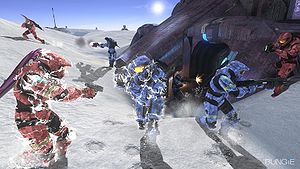
The energy shields flare after taking damage
- “Those Spartans must have shields, right? I saw a Brute hit her so hard she shoulda crumpled like tissue paper.”— Private Harold Amundsen[1]
Energy shielding Is a form of physical shielding consisting of a field of energized particles which will seal around any form of surface, deflecting physical objects. A number of UNSC, Covenant and Forerunner vehicles, starships and armor systems are making use of energy shielding to protect itself from damage.
Human energy shielding
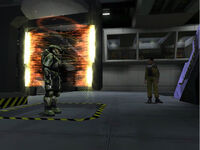
John-117, testing his shields onboard The Pillar of Autumn
The UNSC began using energy shielding around the year 2544, with its first form of energy shielding being the "Bubble Shield", a protective device created by the Office of Naval Intelligence's Beta-5 Division.
During the Fall of Reach, ONI utilized a prototype "drop shield" which had the protective abilities of the bubble shield and the healing abilities of a regenerator.[2] Collapsing under continuous fire, the drop shield proved to be not as indestructible as the bubble shield, and had less healing capability than regenerators. The shield itself greatly resembles the bubble shield, even sporting its counterpart's comprising geometric shapes.[3]

The UNSC Infinity's shields flaring from an impact with an RCS-class armored cruiser.
The first real breakthrough in human energy shield technology came near the end of the Human-Covenant war, when ONI scientists successfully reverse-engineered the technology used in Kig-Yar point defense gauntlets, which led to its incorporation into the MJOLNIR Powered Assault Armor/Mark V and all later versions of the MJOLNIR series.
Another breakthrough in human energy shielding was in the post-war era when shielding became available for capital ships, such as the UNSC Infinity and Strident-class heavy frigate.
Covenant energy shielding
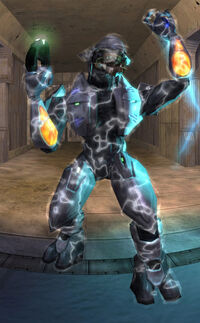
A Covenant Elite's energy shielding.
The Covenant has far more experience in energy shielding, and makes far more extensive use of energy shielding than Humans do.
Personal shielding
Nearly all Sangheili, many Jiralhanae and some of the high-ranking Yanme'e have energy shielding integrated in their personal armor. Kig-Yar warriors use their own form of energy shielding. These shields deflect bullets from point blank range, but leave them vulnerable to sideways firing and explosives.
Starship shielding
Nearly all Covenant vessels are protected by highly resistant energy shields. These shields can take vast amounts of punishment, and recharge very quickly. Covenant shields can absorb practically all missile fire, including hundreds of Archer Missiles and even a nuclear missile. The only UNSC weapon capable of penetrating a Covenant Starship's shield is a Magnetic Accelerator Cannon, but even then, ship based MAC cannons take multiple shots to crack the starship's shields. Only a "Super MAC" used by Orbital Defence Platforms has enough kinetic energy to penetrate a Covenant ship's shield in one single hit.
Covenant starship shielding does have a notable flaw, however: Whenever a starship uses its plasma turret or pulse laser turret, a small section of the energy shield must drop allowing the weapon to fire. Otherwise, the energy released would detonate on the inside of the shields, damaging the ship. While projectile weaponry is generally ineffective against Covenant starship shielding, directed energy weaponry can disable shields with relative ease, in much the same manner as Sangheili energy shields. Another way to disable the shipboard energy shields is through the use of a large-scale electromagnetic pulse.
Stationary shielding
The Covenant make extensive use of stationary energy shield devices.
Forerunner energy shielding
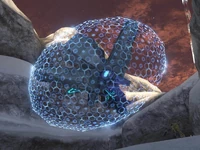
A Sentinel's energy shield.
In all of the Halo campaigns (excluding the Halo 3: ODST and Halo: Reach campaigns), the player encounters several Sentinels that are equipped with energy shields, implying that the Covenant's shielding technology was scavenged from Forerunner technology. Their shields are about equal to an Elite's. The Enforcer is also shielded, and can absorb more damage than a normal Sentinel. The shield, which only guards the front area of the machine, is nearly immune to ballistic weapons, similar to the Jackal shield, but is weak against plasma weapons. In the novel, Ghosts of Onyx, a group of Spartan-IIIs encounter a unique type of Sentinel. While other types of shielding are always active, the shields of an Onyx sentinel only activates if an fast moving object approaches. However, this can be overcome by slow moving projectile such as rocks, and in one case, being boarded by a Spartan. Two or more of the Onyx sentinels can link together to allow their shields to work in conjunction with its weapons.
It was also revealed that the Huragok are equipped with a personal energy shield which activates only when they are under stress. Additionally, these Huragok are also able to project an energy shield around its allies, or enhance shielding already present, if they are within its proximity.
Promethean Knights and Watchers found on Requiem are also seen to possess full body shielding, however this appears to be of a different design to that found on other Forerunner constructs. Promethean shields are far more resilient than those of a standard Sentinel. A hit at the shield doesn't cause the Prometheans whole shield to flare like other shields observed, instead it flares where there is an impact. It is stated by Spartan Thorne that their shields are composed of hard light. Though this version of hard light is different than other versions of hard light in that it is stretched around the whole body of the Knight instead of being in one flat plane.
Energy shields in-game
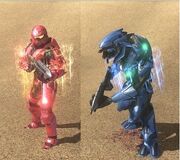
A SPARTAN's and Elite's shield recharging in multiplayer.
- Both in Campaign and Multiplayer shields protect you for a brief amount of time from small arms and weapons. However, in Multiplayer, you can have no shields, 50%, 100%, 200%, 300%, 400% (Halo: Combat Evolved), 500%, 1000%, 2000% or invulnerable shields. Both Elites and Spartans have the same amount of shielding. A player's shields can be further augmented if they pick up an Overshield.
- Each game has a specific time delay before energy shields begin recharging, and a certain amount of time it takes for a full recharge after the delay has passed, shown in the following table:
| Game | Delay | Full recharge |
|---|---|---|
| Halo: Combat Evolved | 5 s | 4 s |
| Halo 2 | 4.25 s | 1.75 s |
| Halo 3 | ||
| Halo: Reach Multiplayer Sangheili |
6 s 4.5 s |
2.75 s 3.5 s |
| Halo 4 | 6 s | 2 s |
- A Regenerator or a Regeneration Field can be used to make your shields recharge very quickly after taking damage.
- If a player deploys a Bubble Shield they will be protected from weapons fire by a spherical energy shield.
- Activating the Deployable Cover will generate a stationary energy shield that regenerates after disabled by continuous damage.
- Shield doors can be found on several maps and can be placed in all DLC maps in Forge.
Trivia
- Contrary to popular belief, the Energy Shield is always present, even while not under fire. However, under the stress and strain of projectile resistance when under fire, it glows blue/gold in an electrical design around the wearer's body, eventually giving way to heavy fire. The Energy Shield is marked as a constant, unwavering protection that covers a Spartan or Elite's entire body, safeguarding the player from any known projectile that isn't more potent than bullets or plasma.
- In Halo: Combat Evolved, the shielding that Sangheili use is slightly stronger than that of a Spartan. Elites' shields only take 70% of the damage that projectile weapons deal out, whereas a Spartans shielding tends to take full damage. (Case in point, the Spartan shield, with 75 hit points, only takes three shots from the M6D Pistol to break, whereas a Minor Elite's shield, which has 100 hit points, takes 8 shots from the same weapon.) Apparently this was changed in Halo 2 and 3 - in Halo 2, it takes four bursts from a Battle Rifle to break either a Spartans shield or a Sangheili Minor's shield.
- It is never fully explained what happens to the plasma bolts or bullets when they make contact with the Energy Shield; however, it is witnessed that most bullets disappear, plasma always following this, whilst some bullets will bounce off the armor, usually at a 1 out of every 7 ratio (except in Halo: Combat Evolved, which had far different gameplay from Halo 2 and 3, and the only shots that will bounce are that of the Needler).
- In Halo 3, in Campaign, the energy shields of Shielded Flood Combat forms do not flare when taking damage, like the Brute Power Armor. However, other Elite's shields still flare when taking damage.
- In Halo 3: ODST, certain Yanme'e are outfitted with personal shields.
- In Halo: Reach, your shields are weaker then they are in Halo 2 and Halo 3, possibly due to the armor being MJOLNIR Mk. V.
- Energy shields seem to nullify friction. An example is in Halo: The Fall of Reach, when John-117 nearly slips when testing out his new Mark V energy shields. He corrected this by reducing the shield levels under his feet.
- The huge advancements in shielding technology by the UNSC following the Human-Covenant war are likely due to the capture of many Huragok on Trevelyan.
- This can be backed up by the UNSC Infinity and her Strident-class heavy frigate compliments, having powerful energy shields.
- Unlike the other Halo games, in Halo Wars the Covenant Wraith and Ghost are capable of shielding. The Wraith is equipped with a Heavy Shield, and the Ghost is equipped with a Scout Shield.
Gallery
Sources
- ↑ Halo: Spartan Assault, Random Pre-Game Quote
- ↑ Halo Waypoint Lars Bakken Interview
- ↑ Halo: Reach Firefight gameplay








